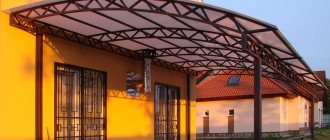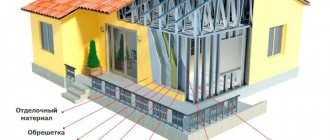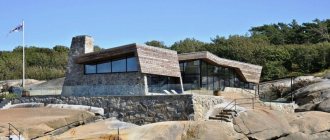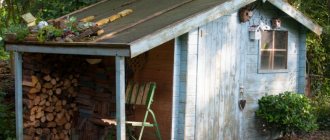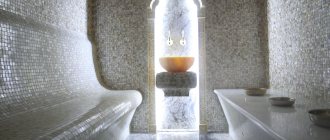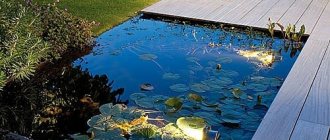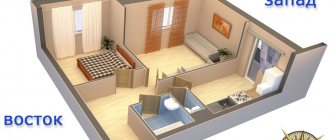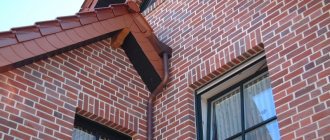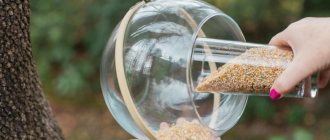Any owner of a site first of all faces the problem of fencing the site. The fence is subject to requirements for safety, aesthetics, durability, strength, and ease of maintenance.
One of the most popular and affordable options for a stylish fence is a fence made of corrugated board. This article talks about how to make a fence from corrugated board with your own hands.
What is corrugated sheeting
Corrugated sheeting is a profiled galvanized steel sheet, a modern facing material used for the construction of walls, fences and roofs. It has a wavy and trapezoidal shape; for fences, a corrugated trapezoidal sheet with a low wave height of up to 20 mm is used.
In private homes, they usually use profiled sheets with a plastic coating over galvanization - this increases the service life of the fence for many years.
Profiled sheets for fences: sizes, prices, brands
A metal profile for building a fence must not only hide the area from prying eyes, but also be strong enough to withstand wind and rain, and accidental mechanical damage.
Standard sizes of corrugated sheets for fences and their markings
The metal profile has three standard markings:
- grade N – used for roofing work;
- grade C – suitable for fences and walls;
- NS brand - considered universal and used for roofs and fences.
The material is produced in different colors
After the letter in the sheet markings there are numbers. They indicate the height of the ridge. For example, the C35 brand means that the wave height on this profile is 35 millimeters. The length of the corrugated sheet varies from half a meter to fourteen meters. The standard length is 2 meters.
| Brand | Full width, mm | Working width, mm | Ridge height, mm | Material thickness, mm | Pitch m/d ridges, mm |
| C8 | 1200 | 1150 | 8 | 0.4-0.8 | 62.5 |
| C10 | 1155 | 1100 | 10 | 0.4-0.8 | 45 |
| S20 | 1150 | 1100 | 20 | 0.45-0.7 | 137.5 |
| S21 | 1051 | 1000 | 21 | 0.4-0.7 | 65 |
| NS35 | 1600 | 1000 | 35 | 0.5-0.9 | 70 |
Helpful information! For corrugated sheets, one edge of the wave is slightly smaller than the other. This should be taken into account when joining the material. The larger wave is superimposed on top of the smaller one.
Installation diagram of metal profile sheets
Profiled sheet for a fence: product price
| Profile view | Brand | Average price r/m2 |
| Galvanized 0.35 mm | C8 | 170 |
| C10 | 199 | |
| S20 | 206 | |
| C15 | 212 | |
| NS35 | 238 | |
| Polyester coating 0.35 mm 25 microns | C8 | 224 |
| S20 | 234 | |
| NS35 | 270 | |
| C15 | 270 | |
| C10 | 276 | |
| Galvanized 0.4 mm | C8 | 199 |
| S20 | 207 | |
| C10 | 216 | |
| NS35 | 225 | |
| C15 | 228 | |
| Polyester coating 0.4 mm 025 microns | C8 | 260 |
| S20 | 272 | |
| C10 | 279 | |
| K25 | 281 | |
| C15 | 290 | |
| NS35 | 299 | |
| Polyester double-sided 0.4 mm 025 microns | C8 | 298 |
| C20 | 311 | |
| C21 | 340 |
Advantages of corrugated sheets
Profiled sheets as a fencing material have many advantages:
- durability - with proper installation, a profiled sheet coated with a polymer coating will last more than 30 years. In European countries there are fences whose service life has already reached 50 years;
- corrosion resistance – the combination of a galvanized layer and a polymer reliably protects the steel from air access and rusting
- strength. Despite its small thickness, thanks to its wave-like shape, the sheet acquires additional rigidity, withstands pressure well and does not bend under wind load;
- resistance to mold, fungi and pests;
- functionality: the fence is opaque, it is almost impossible to get over the fence made of corrugated sheets - the upper sharp edge cuts your hands;
- low cost;
- aesthetics. The plastic covering has a very wide range of colors and patterns, which allows you to choose the fence to match any color of the house and estate buildings; Fences with patterns imitating stone and brick are very popular now, but there are more original designs - flowers, greenery, landscapes, paintings, photos;
- simple installation - this work can be easily done with your own hands;
- low weight allows you to build a lighter columnar foundation; the sheets are easier to transport, carry and install.
Features of installing a fence on an uneven area
There are cases when the area where the fence is planned to be installed is located at an angle or has uneven terrain. You can try to level the territory, but most often this is not possible or financially expensive. What to do in such a situation? In this case, the installation of the fence will have to take into account the unevenness of the soil.
If the slope is steep, sectional or combined fences are installed. They fit perfectly into uneven landscapes and have a fairly aesthetic appearance. A similar effect is achieved through the construction of a stepped foundation. Construction requires certain subtleties, such as calculating the height and width of each span, and measuring the angle of inclination. If the angle does not exceed 35 degrees, then the span width should be at least 2.5 meters.
It is possible that the slope is uneven. In such a case, the problem can be solved by forming sections of different widths. If the slope angle exceeds the specified value, the span pitch should be shortened. As for the upper border of the fence, various design options are acceptable. You can make it stepped, reflecting the shape of the foundation, or linear.
Everyone can realize their preferences. Another important feature when building a fence from corrugated sheets with your own hands on an uneven area is that it is recommended to use a strip foundation.
Even after thoroughly studying the construction instructions, an inexperienced master can make mistakes. To ensure that the appearance of the final structure pleases the eye and does not cause disappointment, let's look at the possible mistakes that are often made when installing a fence from corrugated sheets. Once you become familiar with them, it will be easier to avoid them.
Disadvantages of corrugated sheets
There are few disadvantages of corrugated sheets, but they still exist:
- the corrugated sheet is not resistant to vandalism - the steel under the scratched coating begins to rust (but you can paint over the scratches with special compounds);
- This is not the most burglar-resistant type of fence: a thin sheet can be cut with tin snips and penetrate the yard. But with preparation, you can overcome any fence, and such a fence will reliably protect you from yard thieves and hooligans;
- A sheet fence does not go well with forging, polycarbonate, or wood - it is good on its own.
Read here DIY ceiling lighting - the best ideas for using LED lighting and tips for installing it (120 photos)
Preparing to install a corrugated fence
Installation of a fence made of corrugated sheets is quite simple and accessible to every home craftsman. Any work begins with measuring the site and drawing an accurate drawing or diagram. Then they decide what height of the fence is needed. Most often, the fence is 2 m high. You can look through a lower fence, a higher one is heavier and requires a reinforced foundation.
Then the placement of the pillars is marked on the plan and the required amount of materials is calculated. They purchase and deliver in advance.
The consumption of sheet and metal can be calculated in advance; cement, sand and crushed stone must be purchased approximately 20% more than the calculated quantity - it is impossible to perfectly drill holes for the foundation, and a little more materials are usually required.
If we make a fence from corrugated sheets with our own hands, the resulting savings will be approximately equal to the cost of materials.
Preparatory work
So, we have decided what we want our future fence to look like and have prepared all the necessary tools and equipment. We also sorted out the materials for construction. Now, when starting work, it is important to take correct measurements. Initially, the site is measured and the estimated height of the structure is determined. It will be useful to decide on the place where there will subsequently be a gate or gate for the entry of vehicles.
It is worth noting, whether installing a fence yourself or having it installed by specialists, we cannot do without support posts. Therefore, when starting construction, we need to make markings, indicating the boundaries of our fence. Then we measure the distance between the end points and estimate how many intermediate posts we need in total. We stretch a rope or tight cord between the outer poles. This is our guideline, according to which the marking is essentially made. The distance between the pillars is usually 2-3 meters.
Important point!
Experts do not recommend making the distance to the next post more than 3 meters, otherwise the veins from the profile will lose stability and will sway. But there is no need to do too short intervals.
Repeat the action as many times as necessary, taking into account the length of the future fence. In the marked places we need to make a hole with a diameter of about 25 cm and a depth of 1-1.5 meters. The depth of the hole depends on the type of soil in your area, the height of its freezing and the expected height of the fence itself. These pits are intended for support pillars, the foundation of which we will concrete. You can, of course, dig with a shovel. But in this case, the process will probably take a lot of time and effort, so special equipment, for example, a garden drill, is better suited. From above, each hole needs to be widened by a shovel bayonet measuring about 40 cm.
Frame structure
The fence is mounted on transverse joists. They are usually made from a thinner pipe - 60x60 mm. For a low fence, two crossbars are enough; for a fence height of more than 2 m, 3 or 4 are needed. The logs are cut to size and welded to the supports.
- Pool finishing: description of all types and features of modern finishing
- How an independent examination of construction work is carried out: an overview of all stages
Fasteners for the construction of frame houses: features of the right choice
Mounting horizontal joists
The support pillars are installed, the concrete mixture is finally fixed and dried (it is necessary to allow time for the concrete mixture to harden according to the instructions, this will ensure that the fence will not move). Now you can mount the horizontal logs to the frame.
Transverse logs are placed parallel to each other, usually in two tiers. If the fence height is planned to be more than two meters, then you will need to install a third guide, which is attached exactly in the center. The boundaries of the upper and lower tier vary within 25-30 cm from the expected edge of the corrugated sheet.
The strength of the structure directly depends on the chosen method of fastening. The ideal option is to weld the logs to metal poles using a welding machine. This is a fairly reliable method, but it will require certain welding skills.
There is another way - you can attach the logs using bolts and nuts. Perhaps less reliable, but easier to implement. You need to start fastening from the top tier. The most commonly used profile is with a cross section of 25*50 mm. It is worth noting that if the upper veins are aligned evenly, then the process of aligning the lower rows will proceed easily along the entire perimeter of our fence.
It is recommended to clean all surfaces of metal structural elements, prime them well, and then paint them to match the profiled sheet with two layers of enamel.
Fastening corrugated sheets
Sheets are cut to height (if necessary). The outermost sheet often has to be cut to width. The cut edges must be painted over with special paint with anti-corrosion properties.
The sheets are screwed to the crossbars in that part of the wave that fits tightly to the crossbar. The sheets are overlapped. The distance from the sheets to the ground should be at least 5 cm, and preferably 10 cm. Roofing screws and rubber washers are used.
Support pillar material
In order for the corrugated sheet structure to be securely installed, craftsmen advise mounting it on a frame made of metal pipes. The cross-section can be rectangular, round or square. The diameter of the tube is 5 cm, the wall thickness is from 2.5 mm.
When selecting material, you must take into account the possible strength of wind gusts. For example, if you live near the sea, secure the fence as securely as possible. To do this, install it on the strongest pipes. Sometimes pillars are made of brick or natural stone.


